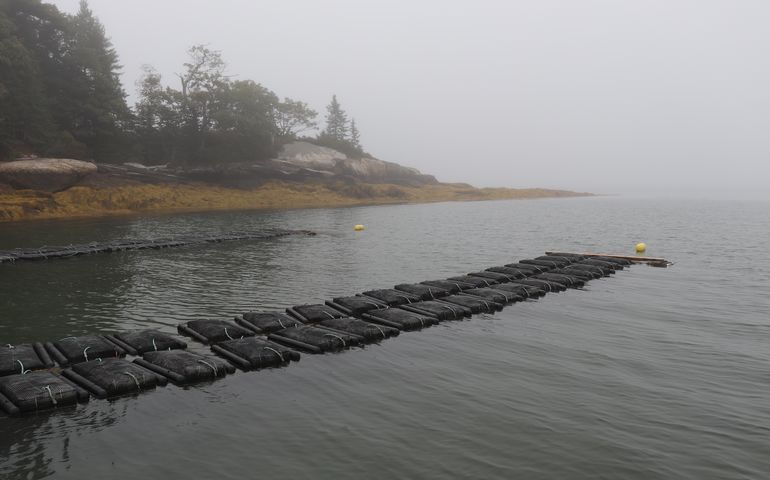
$400K in federal funds may help open new markets for Maine aquaculture
 COURTESY / MAINE AQUACULTURE ASSOCIATION
New federal funding will support a project to explore new and underserved markets for Maine’s aquaculture industry, which pivoted to new distribution channels in the past year. Seen here is Love Point Oyster Farm in Freeport.
COURTESY / MAINE AQUACULTURE ASSOCIATION
New federal funding will support a project to explore new and underserved markets for Maine’s aquaculture industry, which pivoted to new distribution channels in the past year. Seen here is Love Point Oyster Farm in Freeport.
A research project looking at new and underserved markets for Maine’s aquaculture industry has been awarded $400,499 in federal funding from the National Oceanic and Atmospheric Administration’s National Sea Grant program.
The award, announced Friday, will go to the Maine Sea Grant, according to a news release.
"The COVID-19 pandemic has had a tremendous negative impact on all seafood producers,” said Sebastian Belle, the association’s executive director. “The work that will be done in this project will be critical in helping our members adapt to and recover from the challenges they are facing.”

The award will support the research of potential new and underserved markets for Maine-grown aquaculture products, and will fund efforts to seek partnerships between aquaculture and wild capture supply chains.
“Maine’s aquaculture industry has undergone significant growth and diversification in recent years, creating new jobs and economic opportunities in our state,” U.S. Sens. Angus King, I-Maine, and Susan Collins, R-Maine, said in a joint statement.
“Despite this growth, the COVID-19 pandemic has created new obstacles for aquaculture farmers, who rely heavily on the restaurant industry to keep their businesses afloat.”
The industry-propelled project, called “Expanding Maine’s Blue Economy” and led by the association’s project manager, Christian Brayden, will seek to address two objectives:
• Identify barriers and opportunities in existing aquaculture and other seafood supply chains to support increased consumption of Maine marine aquaculture products within U.S. markets;
• Evaluate consumer preferences for Maine marine aquaculture products with varying attributes and branding.

“Maine’s blue economy faces a daunting future, where a decline in wild-capture fisheries and an increase in regulations challenge the backbone of Maine’s coastal communities,” according to the project description.
In response, many fishermen and other coastal residents have turned to aquaculture.
“Then, COVID-19 arrived, reducing demand to a fraction of its former status, causing supply to outpace demand,” the description continued. “Growers, even before COVID-19, had expressed strong interest in exploring new, out-of-state markets. Now, it is a necessity.”
In exploring new markets, the proposal will also assess the seafood supply chain and seek synergies between aquaculture and wild capture seafood. Improving the understanding of the Maine aquaculture industry’s marketing needs, the seafood supply chain and consumer preferences could improve the long-term economic sustainability of aquaculture in Maine.
The award was part of National Sea Grant’s overall $4.7 million in federal funding to support 12 research projects nationwide, to advance the understanding of the economics of aquaculture businesses and provide the industry with important market information to aid sustainable growth.
Grant recipients must match 50% of their funding with nonfederal funds. National Sea Grant received 41 full proposals meeting minimum submission requirements that requested over $17 million in federal funds.
In 2019, National Sea Grant’s investment in aquaculture produced economic benefits worth $80 million, including sustaining or creating 1,052 jobs and 408 businesses.
The U.S. currently imports greater than 85% of its seafood, resulting in a $16.8 billion trade deficit. Maine aquaculture’s primary market is primarily in the U.S.
Like the wild fisheries, the aquaculture industry felt an enormous impact early in the pandemic with the shutdown of restaurants, the industry’s largest market and the setting where most seafood, wild and farmed, is consumed.
Last October, Belle told Mainebiz the pandemic has forced an evolution of some of the industry’s distribution channels at an accelerated rate, including direct distribution to consumers and retail.
The Maine Aquaculture Association has developed new planning and risk management tools for aquaculture businesses which, along with two new hires, represent a concentrated effort to grow Maine’s aquaculture sector.
The association was established in 1978 as a nonprofit trade association that advocates for Maine’s aquatic farmers — including shellfish, finfish and sea vegetable producers — at the state, federal, and international levels. It was the first aquatic farmers’ association in the U.S., according to its website.
Interest in aquaculture has surged since then. For about a decade, the sector has been seeing a huge increase in the number of commercial fishermen getting into aquaculture as a supplemental income, and the sons and daughters of commercial fishermen who have been unable to get permits for wild fisheries. Young adults who aren’t from fishing families are also looking to get into the business. And there’s increasing activity in the educational community to use aquaculture to teach STEM curriculum.










0 Comments